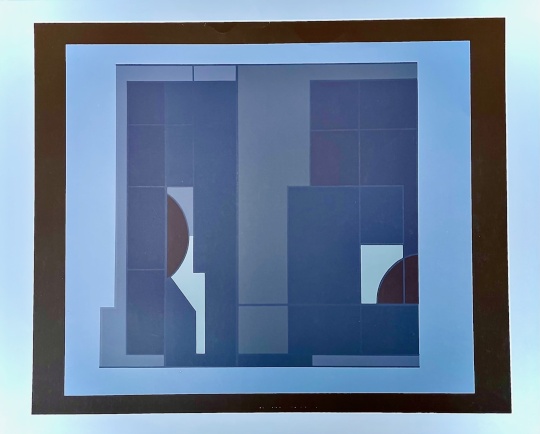Barcsay, Jenő
BiographyARTWORKS FOR SALE
Biography
The outstanding painter and graphic artist, Jenő Barcsay was born on January 14th of 1900, in Katona. He planned to become a musician, but Károly Gulyás discovered his artistic talent and recommended him to Sándor Soófalvy Illyés. Barcsay became Soófalvy's student for over a year. He was accepted to the Hungarian Academy of Fine Arts in 1919, graduated in 1924, and subsequently stayed at the university for two more years as an apprentice. He studied with János Vaszary and Gyula Rudnay.
In 1926 he went to Paris on a one-year scholarship, but spent the second semester in Italy. In 1929, he once again applied for the scholarship and returned to Paris.
In 1945, he became a professor of anatomy at the Hungarian Academy of Fine Arts, with the support of István Szőnyi. In 1953, he was commissioned to write an anatomy textbook, which he finished within a few months. He received the "Most beautiful book of the year" award for it. His book has been translated into several languages, and is still used as a textbook at universities. Barcsay is also a recipient of the Kossuth-award.
He taught at the academy until retirement.
Since the 1960s, Barcsay has created numerous large mosaics. His mosaics were exhibited at the Ernst Museum in 1966. In 1969, he got a commission to create a mosaic for the Szentendre Cultural Center. He used a golden background for the first time, and glass from Murano to build it.
He lived and worked in Budapest and Szentendre until his death. Besides painting, he did a significant amount of graphical work as well. He is considered one of the most prominent figures of the Hungarian constructivist-geometrical arts.
| Year | Biography |
|---|---|
| 1900 | Born in Katona |
| 1919-1922 | Hungarian Academy of Fine Arts |
| 1925 |
First group exhibition (Ernst Museum) |
| 1929 | First time in Szentendre |
| 1945 | Professor of anatomy at the Hungarian Academy of Fine Arts |
| 1945 | Started working on abstract female figures and landscapes |
| 1950's | The neoclassical version of the female figure appeared in his arts |
| 1960's | Worked on non-figurative, geometric pictures |
| 1962 | Travelled to Paris |
| 1970 | II Festival International de Peinture |
| (International painting festival), Cagnes-sur-Mer (FR) | |
| Lived and worked in Budapest and Szentendre until his death | |
| Teachers: János Vaszary, Gyula Rudnay | |
| Awards | |
| 1938 | Mihály Zichy graphical prize |
| 1954 | Kossuth-award |
| 1985 | Kossuth-award |
| 1955 | Tornyai-medal |
| 1964 | Merited artist |
| 1967 | Pro Arte-award |
| 1969 | Outstanding artist |
| 1983 | SZOT-award |
| Single exhibitions | |
| 1987 | Erdei F. Cultural Center, Kecskemét |
| 1986 | Műhely Gallery, Szentendre |
| 1985 | Art Gallery, Győr |
| 1985 | Dürer Hall, Gyula |
| 1984 | Hungarian National Gallery, Budapest |
| 1982 | Art Gallery, Budapest |
| 1977 | Red Chapel, Balatonboglár |
| 1976 | Uitz Hall, Dunaújváros |
| 1975 | Gallery of Hatvan, Hatvan |
| Hungarian House of Culture, Warsaw | |
| 1972 | Helikon Gallery, Budapest |
| 1971 | Janus Pannonius Museum Modern Gallery, Pécs |
| 1970 | Szentendre mosaics, Art Gallery, Budapest |
| 1969 | A birth and history of a mosaic, Ferenczy Museum |
| Szentendre | |
| 1967 | Ottó Herman Museum, Miskolc |
| 1966 | Ernst Museum, Budapest |
| 1964 | XXXII. Biennial of Venezia, Venezia |
| 1957 | National Salon, Budapest |
| 1941 | Ernst Museum, Budapest |
| 1947 | Art Gallery, Budapest |
| 1944 | Artistic Creation Hose, Budapest |
| 1936 | Ernst Museum, Budapest |
| 1932 | Tamás Gallery, Budapest |
| 1925 | Ernst Museum, Budapest |
| Selected group exhibitions | |
| 1980 | XXXIX. Biennial of Venezia, Venezia |
| 1976 | XXXVII. Biennial of Venezia, Venezia |
| 1970 | IIe Festival International de Peinture |
| (International Painting Festival), Cagnes-sur-Mer (FR) | |
| 1969 | I. Biennial of Nürnberg, Nürnberg |
| 1968 | Ungarische Kunst der Gegenwart, Museum Volkwang, Essen |
| 1966 | Exposition de Peinture, Sculpture |
| et Arts Graphiques Hongrois du Xe au XXe siècle, Párizs | |
| 1945-1947 | Europina school's exhibitions, Budapest |
| Works in public collections | |
| Ferenczy Museum, Szentendre | |
| Capital Gallery, Budapest | |
| Szentendre | |
| Janus Pannonius Museum, Pécs | |
| Hungarian National Gallery, Budapest |



















